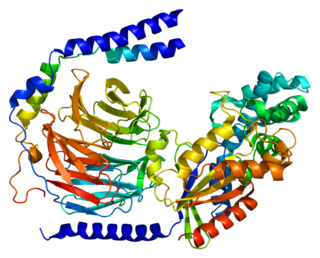Guanine nucleotide-binding protein G(o) subunit alpha is a protein that in humans is encoded by the GNAO1 gene. [5] [6] [7]
Contents
Mutations in this gene have been shown to cause epileptic encephalopathy. [8]
Guanine nucleotide-binding protein G(o) subunit alpha is a protein that in humans is encoded by the GNAO1 gene. [5] [6] [7]
Mutations in this gene have been shown to cause epileptic encephalopathy. [8]
GNAO1 has been shown to interact with:
G12/G13 alpha subunits are alpha subunits of heterotrimeric G proteins that link cell surface G protein-coupled receptors primarily to guanine nucleotide exchange factors for the Rho small GTPases to regulate the actin cytoskeleton. Together, these two proteins comprise one of the four classes of G protein alpha subunits. G protein alpha subunits bind to guanine nucleotides and function in a regulatory cycle, and are active when bound to GTP but inactive and associated with the G beta-gamma complex when bound to GDP. G12/G13 are not targets of pertussis toxin or cholera toxin, as are other classes of G protein alpha subunits.

Guanine nucleotide-binding protein G(q) subunit alpha is a protein that in humans is encoded by the GNAQ gene. Together with GNA11, it functions as a Gq alpha subunit.

Guanine nucleotide-binding protein G(i), alpha-1 subunit is a protein that in humans is encoded by the GNAI1 gene.

Regulators of G protein signaling (RGS) are protein structural domains or the proteins that contain these domains, that function to activate the GTPase activity of heterotrimeric G-protein α-subunits.

GIPC PDZ domain containing family, member 1 (GIPC1) is a protein that in humans is encoded by the GIPC1 gene. GIPC was originally identified as it binds specifically to the C terminus of RGS-GAIP, a protein involved in the regulation of G protein signaling. GIPC is an acronym for "GAIP Interacting Protein C-terminus". RGS proteins are "Regulators of G protein Signaling" and RGS-GAIP is a "GTPase Activator protein for Gαi/Gαq", which are two major subtypes of Gα proteins. The human GIPC1 molecule is 333 amino acids or about 36 kDa in molecular size and consists of a central PDZ domain, a compact protein module which mediates specific protein-protein interactions. The RGS-GAIP protein interacts with this domain and many other proteins interact here or at other parts of the GIPC1 molecule. As a result, GIPC1 was independently discovered by several other groups and has a variety of alternate names, including synectin, C19orf3, RGS19IP1 and others. The GIPC1 gene family in mammals consisting of three members, so the first discovered, originally named GIPC, is now generally called GIPC1, with the other two being named GIPC2 and GIPC3. The three human proteins are about 60% identical in protein sequence. GIPC1 has been shown to interact with a variety of other receptor and cytoskeletal proteins including the GLUT1 receptor, ACTN1, KIF1B, MYO6, PLEKHG5, SDC4/syndecan-4, SEMA4C/semaphorin-4 and HTLV-I Tax. The general function of GIPC family proteins therefore appears to be mediating specific interactions between proteins involved in G protein signaling and membrane translocation.

Guanine nucleotide-binding protein G(z) subunit alpha is a protein that in humans is encoded by the GNAZ gene.

Guanine nucleotide-binding protein G(I)/G(S)/G(T) subunit beta-2 is a protein that in humans is encoded by the GNB2 gene.

Guanine nucleotide-binding protein G(I)/G(S)/G(O) subunit gamma-2 is a protein that in humans is encoded by the GNG2 gene.

Regulator of G-protein signaling 19 is a protein that in humans is encoded by the RGS19 gene.

Guanine nucleotide-binding protein subunit beta-5 is a protein that in humans is encoded by the GNB5 gene. Alternatively spliced transcript variants encoding different isoforms exist.

Guanine nucleotide-binding protein G(t) subunit alpha-2 is a protein that in humans is encoded by the GNAT2 gene.

Guanine nucleotide-binding protein G(t) subunit alpha-1 is a protein that in humans is encoded by the GNAT1 gene.

Regulator of G-protein signaling 1 is a protein that in humans is encoded by the RGS1 gene.

Regulator of G-protein signaling 14 (RGS14) is a protein that in humans is encoded by the RGS14 gene.

Guanine nucleotide-binding protein subunit beta-4 is a protein that in humans is encoded by the GNB4 gene.

Guanine nucleotide-binding protein subunit alpha-13 is a protein that in humans is encoded by the GNA13 gene.

Guanine nucleotide-binding protein G(k) subunit alpha is a protein that in humans is encoded by the GNAI3 gene.

Guanine nucleotide-binding protein subunit alpha-11 is a protein that in humans is encoded by the GNA11 gene. Together with GNAQ, it functions as a Gq alpha subunit.

Guanine nucleotide-binding protein subunit alpha-12 is a protein that in humans is encoded by the GNA12 gene.

GoLoco motif is a protein structural motif. In heterotrimeric G-protein signalling, cell surface receptors (GPCRs) are coupled to membrane-associated heterotrimers comprising a GTP-hydrolyzing subunit G-alpha and a G-beta/G-gamma dimer. The inactive form contains the alpha subunit bound to GDP and complexes with the beta and gamma subunit. When the ligand is associated to the receptor, GDP is displaced from G-alpha and GTP is bound. The GTP/G-alpha complex dissociates from the trimer and associates to an effector until the intrinsic GTPase activity of G-alpha returns the protein to GDP bound form. Reassociation of GDP-bound G-alpha with G-beta/G-gamma dimer terminates the signal. Several mechanisms regulate the signal output at different stage of the G-protein cascade. Two classes of intracellular proteins act as inhibitors of G protein activation: GTPase activating proteins (GAPs), which enhance GTP hydrolysis, and guanine dissociation inhibitors (GDIs), which inhibit GDP dissociation. The GoLoco or G-protein regulatory (GPR) motif found in various G-protein regulators. acts as a GDI on G-alpha(i).